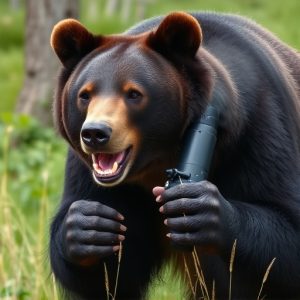Bear Spray: Legal Use and Protection in Wildlife Encounters
Bear spray, a potent capsaicin-based deterrent, varies in legality and effectiveness across regions,…….
Bear spray, a potent capsaicin-based deterrent, varies in legality and effectiveness across regions, with some allowing its use in bear country while others prohibit it due to environmental concerns. It's crucial for adventurers to know local rules regarding bear spray usage, aiming for 20-30 feet range, and understanding its reduced effectivity in wet or windy conditions. Where carrying bear spray is forbidden or impractical, alternative safety measures like noise making, secure food storage, and understanding bear behavior become essential for safe encounters.
“Wildlife encounters, especially with bears, can be thrilling yet dangerous. Enter bear spray—a game-changer in personal protection. This article demystifies this powerful tool, offering insights into its composition, effectiveness, and legal considerations. We explore where bear spray is both permitted and prohibited, providing essential best practices for safe usage during wildlife encounters. Additionally, we delve into alternative safety measures beyond spray, ensuring a comprehensive guide to navigating the great outdoors with confidence.”
- Understanding Bear Spray: Its Composition and Effects
- Legal Status and Regulations: Where Is It Allowed?
- Safe Usage and Best Practices for Wildlife Encounters
- Alternative Measures for Bear Safety Beyond Spray
Understanding Bear Spray: Its Composition and Effects
Bear spray, also known as bear repellent, is a crucial tool for anyone venturing into bear country. Its primary purpose is to deter and discourage aggressive behavior from bears, providing an effective means of self-defense in potentially dangerous encounters. Bear spray is typically composed of capsaicin, the same active ingredient found in chili peppers, combined with other chemicals to enhance its effectiveness against bears. When used properly, it creates a temporary yet powerful barrier, allowing individuals to retreat safely and avoid unwanted interactions with these wild animals.
Understanding the composition and effects of bear spray is essential, especially as its use is not universal across all regions. Some areas have strict regulations regarding where and how bear spray can be carried, with certain locations even prohibiting its use entirely. For instance, where grizzly bears are protected or in remote wilderness areas, local authorities might restrict the carrying of bear spray to ensure the preservation of natural behavior patterns and minimize potential harm to both humans and wildlife. Therefore, it’s vital for outdoor enthusiasts to research and comply with local regulations regarding bear spray usage before embarking on their adventures.
Legal Status and Regulations: Where Is It Allowed?
Bear spray, also known as bear repellent, is a popular tool for wildlife encounter protection, especially in areas where bears are present. However, its legal status and regulations vary significantly across different regions. In many countries and states, carrying bear spray is mandatory when hiking or camping in bear country. These regulations aim to ensure public safety and minimize the potential harm caused by unexpected encounters with bears.
Despite its widespread use and benefits, there are certain places where bear spray is either prohibited or heavily restricted. National parks and urban areas often have strict rules against carrying aerosol sprays due to concerns about environmental impact, safety hazards, and visitor experience. Additionally, some regions may allow the use of bear spray only for specific activities like hunting or under specialized permits. Therefore, it’s crucial for individuals planning outdoor activities in bear-inhabited areas to familiarize themselves with local laws and regulations regarding bear spray usage and where it is allowed.
Safe Usage and Best Practices for Wildlife Encounters
When encountering wildlife, especially bears, it’s crucial to understand that bear spray is a tool for deterrence and should be used as a last resort. Always keep in mind that prevention is key; making noise while trekking through known bear country, traveling in groups, and storing food securely are primary precautions.
For those situations where a bear approaches or becomes aggressive, knowing how to properly deploy bear spray is vital. Aim for the bear’s face and eyes, spraying from about 20-30 feet away. Keep the spray can in your dominant hand, ready for quick deployment. Remember, it’s best to back away slowly before using spray, as it should be a last-ditch effort to avoid an attack. Additionally, be aware that bear spray is not effective everywhere; certain environments like wet or windy conditions might reduce its range and effectiveness, highlighting the importance of understanding local regulations regarding its use, including where bear spray is prohibited.
Alternative Measures for Bear Safety Beyond Spray
In situations where carrying bear spray isn’t feasible or prohibited (such as in certain parks or wilderness areas), understanding and employing alternative safety measures become paramount. One effective strategy is to make noise while navigating through potential bear habitats, as it can help deter bears from surprising you. Carrying and using bells on your clothing or equipment, or even singing at a reasonable volume, can alert bears of your presence and reduce the likelihood of an unexpected encounter.
Additionally, maintaining a clean camp and storing food securely is crucial. Bears are attracted to odours, so proper waste disposal and keeping food in airtight containers or hanging them out of reach can significantly minimize the risk of attracting them. Knowing and respecting bear behaviour also plays a significant role; understanding their feeding patterns and habitats allows you to make informed decisions to avoid potential conflict zones during peak seasons.
Bear spray is a valuable tool for personal safety during wildlife encounters, but its usage isn’t universal. While it’s legal and encouraged in many areas, there are regions where its use is strictly prohibited due to environmental concerns or unique local regulations. Understanding the legal status of bear spray in your destination is essential before considering its use. Additionally, proper education and alternative safety measures, such as making noise to deter bears or carrying bear-resistant food containers, can offer effective bear safety strategies that respect wildlife and their habitats.


